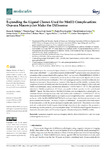Mostrar o rexistro simple do ítem
Expanding the Ligand Classes Used for Mn(II) Complexation: Oxa-aza Macrocycles Make the Difference
| dc.contributor.author | Kálmán, Ferenc | |
| dc.contributor.author | Nagy, Viktória | |
| dc.contributor.author | Uzal-Varela, Rocío | |
| dc.contributor.author | Pérez-Lourido, Paulo | |
| dc.contributor.author | Esteban-Gómez, David | |
| dc.contributor.author | Garda, Zoltán | |
| dc.contributor.author | Pota, Kristof | |
| dc.contributor.author | Mezei, Roland | |
| dc.contributor.author | Pallier, Agnès | |
| dc.contributor.author | Tóth, Éva | |
| dc.contributor.author | Platas-Iglesias, Carlos | |
| dc.contributor.author | Tircsó, Gyula | |
| dc.date.accessioned | 2021-04-06T16:17:45Z | |
| dc.date.available | 2021-04-06T16:17:45Z | |
| dc.date.issued | 2021-03-10 | |
| dc.identifier.citation | Kálmán, F.K.; Nagy, V.; Uzal-Varela, R.; Pérez-Lourido, P.; Esteban-Gómez, D.; Garda, Z.; Pota, K.; Mezei, R.; Pallier, A.; Tóth, É.; Platas-Iglesias, C.; Tircsó, G. Expanding the Ligand Classes Used for Mn(II) Complexation: Oxa-aza Macrocycles Make the Difference. Molecules 2021, 26, 1524. https://doi.org/10.3390/molecules26061524 | es_ES |
| dc.identifier.issn | 1420-3049 | |
| dc.identifier.uri | http://hdl.handle.net/2183/27664 | |
| dc.description.abstract | [Abstract] We report two macrocyclic ligands based on a 1,7-diaza-12-crown-4 platform functionalized with acetate (𝑡O2DO2A²⁻) or piperidineacetamide (𝑡O2DO2AMᴾⁱᵖ) pendant arms and a detailed characterization of the correspondingMn(II) complexes. The X-ray structure of [Mn(𝑡O2DO2A)(H₂O)]∙.2H₂O shows that the metal ion is coordinated by six donor atoms of the macrocyclic ligand and one water molecule, to result in seven-coordination. The Cu(II) analogue presents a distorted octahedral coordination environment. The protonation constants of the ligands and the stability constants of the complexes formed with Mn(II) and other biologically relevant metal ions (Mg(II), Ca(II), Cu(II) and Zn(II)) were determined using potentiometric titrations (∕ = 0.15 M NaCl, T = 25 ºC). The conditional stabilities of Mn(II) complexes at pH 7.4 are comparable to those reported for the cyclen-based 𝑡DO2A²⁻ ligand. The dissociation of the Mn(II) chelates were investigated by evaluating the rate constants of metal exchange reactions with Cu(II) under acidic conditions (∕ = 0.15MNaCl, T = 25 ºC). Dissociation of the [Mn(𝑡O2DO2A)(H₂O)] complex occurs through both proton- and metal-assisted pathways, while the [Mn(𝑡O2DO2AMᴾⁱᵖ)(H₂O)] analogue dissociates through spontaneous and proton-assisted mechanisms. The Mn(II) complex of 𝑡O2DO2A²⁻ is remarkably inert with respect to its dissociation, while the amide analogue is significantly more labile. The presence of a water molecule coordinated to Mn(II) imparts relatively high relaxivities to the complexes. The parameters determining this key property were investigated using ¹⁷O NMR (Nuclear Magnetic Resonance) transverse relaxation rates and ¹H nuclear magnetic relaxation dispersion (NMRD) profiles. | es_ES |
| dc.description.sponsorship | This research was funded by Hungarian National Research, Development and Innovation Office, Projects NKFIH K-120224 and 134694); Ministerio de Economía y Competitividad (CTQ2016-76756-P) and Xunta de Galicia (ED431B 2020/52) | es_ES |
| dc.description.sponsorship | Hungarian Scientific Research; NKFIH K-120224 | |
| dc.description.sponsorship | Hungarian Scientific Research; NKFIH K-134694 | |
| dc.description.sponsorship | Xunta de Galicia; ED431B 2020/52 | |
| dc.language.iso | eng | es_ES |
| dc.publisher | MDPI | es_ES |
| dc.relation | info:eu-repo/grantAgreement/AEI/Plan Estatal de Investigación Científica y Técnica y de Innovación 2013-2016/CTQ2016-76756-P/ES/NUEVA GENERACION DE AGENTES DE CONTRASTE PARA IMAGEN POR RESONANCIA MAGNETICA (IRM) ALTERNATIVOS A LOS DERIVADOS DE GADOLINIO/ | |
| dc.relation.uri | https://doi.org/10.3390/molecules26061524 | es_ES |
| dc.rights | Attribution 4.0 International | es_ES |
| dc.rights.uri | http://creativecommons.org/licenses/by/4.0/ | * |
| dc.subject | Manganese | es_ES |
| dc.subject | Magnetic resonance imaging | es_ES |
| dc.subject | Stability | es_ES |
| dc.subject | Dissociation kinetics | es_ES |
| dc.subject | Water exchange | es_ES |
| dc.subject | Contrast agents | es_ES |
| dc.subject | Macrocycles | es_ES |
| dc.title | Expanding the Ligand Classes Used for Mn(II) Complexation: Oxa-aza Macrocycles Make the Difference | es_ES |
| dc.type | info:eu-repo/semantics/article | es_ES |
| dc.rights.access | info:eu-repo/semantics/openAccess | es_ES |
| UDC.journalTitle | Molecules | es_ES |
| UDC.volume | 26 | es_ES |
| UDC.issue | 6 | es_ES |
| UDC.startPage | 1524 | es_ES |
| UDC.endPage | 1524 | es_ES |
Ficheiros no ítem
Este ítem aparece na(s) seguinte(s) colección(s)
-
GI-REACT! - Artigos [120]






